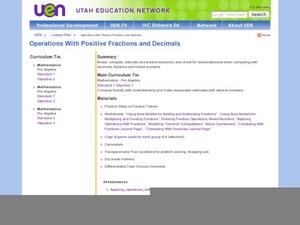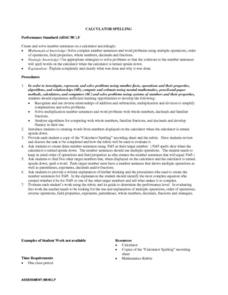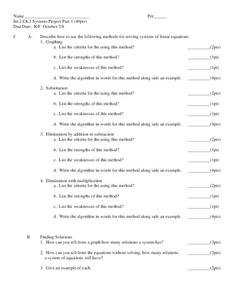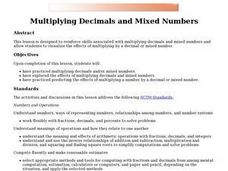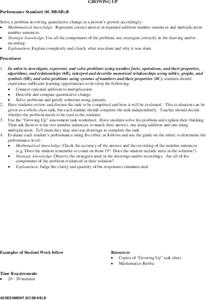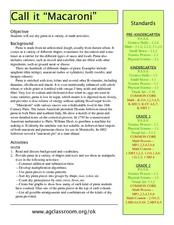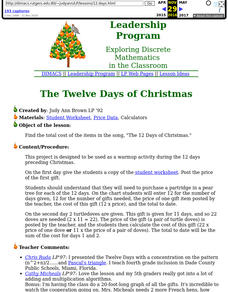Consumers Energy
The Cost of Electricity
How much is your toaster costing you every day? Young environmentalists calculate the monetary costs of household appliances based on their average consumption of wattage.
Curated OER
Operations with Positive Fractions and Decimals
Explore the concept of fractions and decimals! In this fractions and decimals lesson, pupils use fraction tiles to express fractions. They play a fraction review basketball game where when a team gets a question correct they get to shoot...
Curated OER
Problem Solvers
Fifth and sixth graders compare decimals to the place-value structure in the base-ten number system. They represent fractions as parts of unit wholes, as parts of a set, as locations on a number line, and as divisions of whole numbers....
Curated OER
Calculator Spelling
Sixth graders practice creating and solving number sentences on a calculator. They interact with number facts, their properties, algorithms and estimation. Each student recognizes inverse relationships of addition, subtraction,...
Curated OER
Multiplying in Columns, Standard Way
In this multiplying and carrying worksheet, students compare the standard algorithm with the multiplying in parts method and their examples, choose which method to use, and find the products. Students solve twenty problems.
Curated OER
Systems of Equations (Systems Project Part 1)
In this systems of equations worksheet, high schoolers identify and explore three ways to solve systems of equations: graphing, substitution, elimination. They discuss the strengths, weaknesses, and write an algorithm for each method. ...
Curated OER
Matrices: A Secret Weapon
Students perform operations with matrices. In this algebra lesson plan, students use cryptography and cryptanalysis to solve problems. They add, subtract, and multiply matrices.
Curated OER
Hands-On Equations: Teacher Notes
Math manipulatives are wonderful for demonstrating any number of mathematical concepts in a concrete and visual way. Learners review the addition property of equality and the zero property using a scale model kit (not shown). They...
Curated OER
Rational Number Project
Infuse your unit on fractions, decimals, and operations with a thorough module about rational numbers. With a teaching guide, learner examples, templates for instruction, and lesson rationale, the module is a solid way to emphasize the...
Curated OER
Three Digit Multipliers
In this multiplication worksheet, students multiply 3 digit numbers together. Students complete 6 three digit number multiplication problems.
Curated OER
Cooking with Math
Fourth graders practice multiplication and division with cooking recipes. In this math lesson, 4th graders look at a recipe and change it so that it works for twice as many people or half as many people.
Curated OER
Models for Dividing Fractions
Sixth graders represent division of fractions using manipulatives, such as freezer pops, candy bars, and models such as drawings squares. They develop an algorithm from these examples and solve problems using fractions.
Curated OER
Fraction of a Number
Pupils explore how to multiply fractions using color tiles. They use the appropriate strategies for the multiplication of fractions. Students use 40 color tiles to practice multiplying fractions. They practice using various fractions to...
Curated OER
Multiplying Decimals and Mixed Numbers
Learners multiply decimals and/or mixed numbers. They explore the effects of multiplying decimals and mixed numbers. They practice estimating answers when a number is multiplied by a decimal or mixed number.
Curated OER
Growing Up
Students solve a given problem and explain their thinking using two number sentences to match their answer. One number sentence must use addition, one must use multiplication, and students must explain their answers. Includes sample...
Curated OER
Multiplicative Sequences
Students investigate the concepts related to the practice of multiplication facts. They look for number patterns in order to create an algorithm in order to find the correct sequencing of number patterning. The solutions are then...
Curated OER
Call it "Macaroni"
Who knew there were so many fun educational opportunities featuring pasta? Scholars read a brief informational text about the history of pasta (note that "macaroni" is spelled two different ways, so address this if kids are reading...
EngageNY
Estimating Digits in a Quotient
Boiling down any division problem to a one-digit divisor problem sure makes estimation easy. The lesson shows how to estimate division problems by using place value understanding and basic arithmetic facts to simplify the division. Some...
Illustrative Mathematics
How Many Containers in One Cup / Cups in One Container?
The object is to model fraction division by asking “How many are in one group?” It is a difficult concept to understand, but developing the model that shows one cup to a certain amount of container or one container to a certain amount of...
West Contra Costa Unified School District
Modeling Division of Fractions
Introduce young mathematicians to the process of dividing fractions with a hands-on math instructional activity. Using the help of fraction strips and other visual models, children work through a series of example problems as they deepen...
Curated OER
Partial Quotient
Learners study what occurs in the division process, rather than just following prescribed steps. They expand number sense to include integers and perform operations with whole numbers, simple fractions, and decimals. They write a word...
Illustrative Mathematics
Gifts from Grandma, Variation 3
There are three money word problems in this activity, each one is set in the same context. The first asks what was the total amount grandma spent, the second how many grandchildren grandma has, and the third asks how much grandma spent...
Curated OER
Leadership Program in Discrete Mathematics
Students find the total cost of the items in the song, "The 12 Days of Christmas."
K12 Reader
Evaluating Efficiency
There's more than one way to solve a math problem! Introduce your class to this concept with a reading passage. After reading, learners answer five related questions.



